Food and beverage manufacturers that sell products in Mexico have had to make a lot of adjustments to food packages in the past few years. The biggest change has been the implementation of https://dof.gob.mx/2020/SEECO/NOM_051.pdf for most packaged foods, including octagonal warning seals for foods that are high in sugars, trans or saturated fats, calories, or sodium.
The initiative first kicked off in 2020 when Mexico passed revisions for how FOP symbols should be shown on food packaging and what information the symbols convey (you can view the bill in Spanish: Norma Oficial Mexicana NOM-051-SCFI/SSA1-2010). Mexico offered food manufacturers a multi-stage approach to adjust their food packages, and we are now approaching the second phase of implementation. As a reminder, here are the implementation dates:
- Phase 1 – October 1, 2020 – September 30, 2023
- Phase 2 – October 1, 2023 – September 30, 2025
- Phase 3 – Begins and continues after October 1, 2025
In this blog post, we aim to clarify the regulations and highlight the key differences between Phase 2 and Phase 3 requirements. For our Genesis R&D Foods users, we have great news: both Phase 2 and Phase 3 regulations have already been incorporated into the software. This means you can be well-prepared and compliant with Phase 3 regulations long before the official implementation deadline.
Overview of Phase 2
Phase 2 began on October 1, 2023, and builds on the regulations outlined in Phase 1 and introduces several changes and criteria focusing on critical nutrients in processed foods and non-alcoholic beverages.
This phase evaluates:
- Added Sugars: Products with added sugars should be evaluated for sugar and calorie content;
- Added Fats: Products with added fats should be evaluated for saturated fats, trans fats, and calorie content;
- Added Sodium: Products with added sodium should be evaluated for sodium content.
This phase also sets specific thresholds for excess calories, sugars, saturated fats, trans fats, and sodium in both solids and liquids, slightly adjusting the criteria from Phase 1.
Key threshold changes include:
- Excess Calories Liquid: Warning symbol criteria: ≥ 70 kcal total OR ≥ 8 kcal from added sugars (was previously ≥ 10 kcal from added sugars).
- Excess Sugars Liquid: Warning symbol criteria: beverages with <10 kcal from added sugars are no longer exempt.
- Excess Sodium Liquids and Solids: Warning symbol criteria: ≥ 1 mg sodium per kcal or ≥ 300 mg.
Overview of Phase 3
Phase 3, which begins after October 1, 2025, maintains the nutrient thresholds established in Phase 2 but introduces new evaluation criteria for the warning symbols. Specifically, if a product has added sugars, added fats, or added sodium, it will need to be evaluated for all nutrients of concern: Energy (kcal), Sugars, Saturated Fats, Trans Fats, and Sodium.
Thresholds
This table outlines the threshold values for Phase 2 and Phase 3. If a nutrient is required to be evaluated and meets or exceeds the thresholds outlined in the below chart, the corresponding Warning Seal must appear on the product packaging.
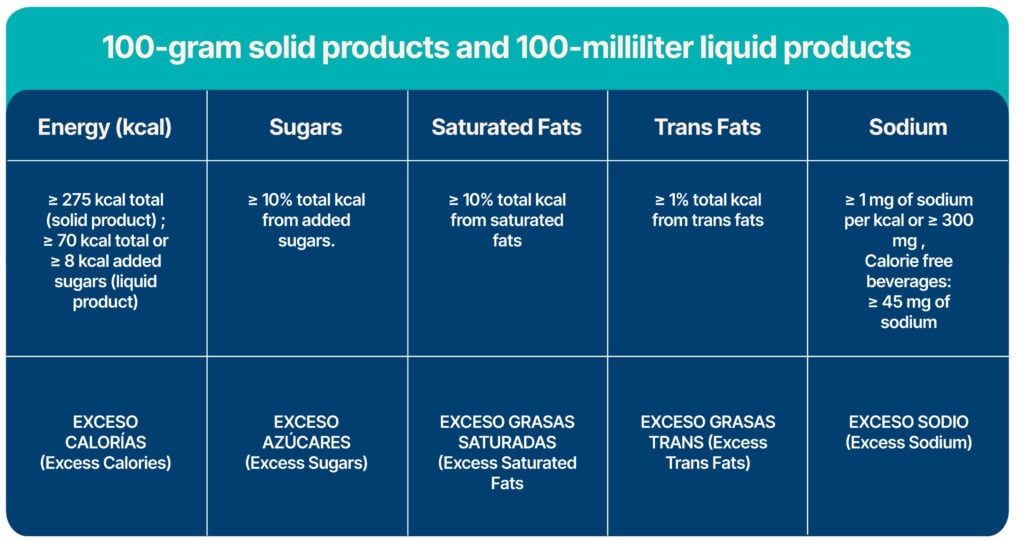
Warning Seals
The warning symbols are octagonal, black, and white seals. Here are examples and the requirements for each:

- Shape: Regular octagon.
- Background color: Black with white outline.
- Font: Arial Bold in white, to contrast with the black background.
- Placement: Primary Display Panel (usually top right corner of the front of a product package).
Food products should display all the warning seals relevant to the food product being packaged. For example, a bag of flavored potato chips could have the excess calories seal, excess trans fat, and excess sodium seals. The regulations also set requirements for how those seals should be ordered and laid out. Here are a couple of examples:
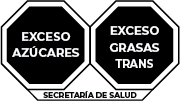
|
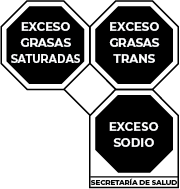
|
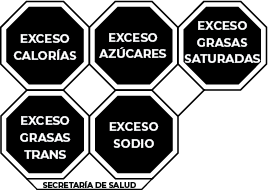
|
Small Packaging Display Guidelines
For food products that have a display area of ≤ 5 cm² must include one seal with a number indicating how many nutrients exceeded the threshold in the food product.
Here are some examples of the numbered seals for small packages:

|

|

|

|

|
Cautionary Warning Statements
The majority of Phase 2 changes relate to the criteria for FOP labeling of foods. However, there are some other changes that carry over from the first phase, including warnings to discourage the consumption of sweeteners or caffeine by children. These symbols should be displayed in the top right corner below other warning seals.
CaffeineA warning statement “Contiene cafeína evitar en niños” (Contains caffeine, avoid giving to children) is required if the product contains any caffeine at all. |
SweetenersA warning statement “Contiene edulcorantes, no recomendable en niños” (Contains sweeteners, not recommended for children), is required on products containing excess sugar. |
 |
|
Don’t Let the Next Phase Catch You by Surprise
Regulatory changes happen all the time, and keeping up with the various international food labeling regulations can be daunting. But before you let the next Phase of Mexico’s updates catch you by surprise, you can get a solution that automatically updates with the latest government guardrails to help you stay compliant with U.S., Canadian, and/or Mexican labeling guidelines.
Genesis Foods offers food manufacturers automated label creation when inputting ingredients, as well as a warning seal notification to let you know when you exceed one of the thresholds in Phase 2 or Phase 3. To learn more about our solution, contact our team today.
Other posts you might be interested in
View All Posts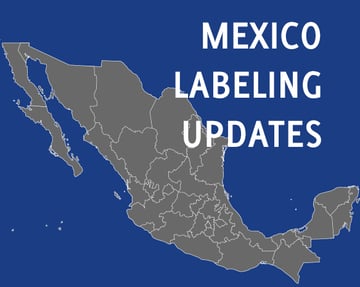
Food Labeling
30 min read
| November 8, 2020
Creating Mexico Front-of-Package Warning Seals and Statements
Read More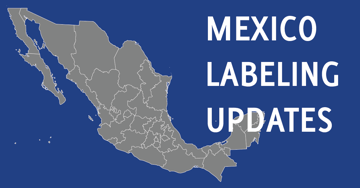
Food Labeling
6 min read
| September 14, 2020
Overview of Mexico’s Front-of-Pack (Phase 1) and Nutrition Labeling Regulation Updates
Read More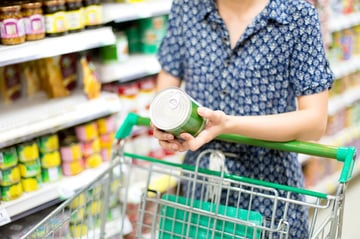
Product Formulation
14 min read
| June 13, 2024

